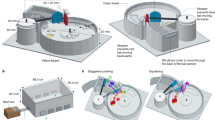Abstract
While studying the ecology of the malaria vector Anopheles (Nyssorhynchus) darlingi Root along the Ituxi River, Amazonas, Brazil, we observed aggregates of bees on the walls of houses that were routinely sprayed with DDT. Several bees collected from DDT-treated house walls in August 1978 were identified as male specimens of Eufriesia purpurata (Moscary) of the tribe Euglossini (Hymenoptera: Apoidae). (The bees were identified as Euplusia purpurata by Anthony Raw, Laboratorio de Ecologia, Universidade de Brasilia. The change of generic name from Euplusia to Eufriesia is based on ref. 1.) These bees were well known to the local residents as the insects that eat DDT and we present here the first documentation that they (1) are attracted to DDT, (2) actively collect large quantities of DDT from treated house walls and (3) suffer no apparent insecticidal effects. We also found that the frequency of house visiting is most intense during July to September. Most bees arrive at houses before 12.00 h, remain 2–3 h and return on subsequent days to collect more DDT. Noise produced by bees as they collected DDT was a notable disturbance to 76% of 21 families interviewed along the Ituxi River.
This is a preview of subscription content, access via your institution
Access options
Subscribe to this journal
Receive 51 print issues and online access
$199.00 per year
only $3.90 per issue
Buy this article
- Purchase on Springer Link
- Instant access to full article PDF
Prices may be subject to local taxes which are calculated during checkout
Similar content being viewed by others
References
Kimsey, L. S. Pan-Pacif. Ent. 55, 193 (1979).
Dressler, R. L. Evolution 22, 202 (1968).
Dodson, C. H., Dressler, R. L., Hills, H. C., Adams, R. M. & Williams, N. H. Science 164, 1243–1249 (1969).
Manual of Analytical Methods for the Analysis of Pesticides in Residues in Human and Environmental Samples, Sect. 5, 2 (2) (USEPA, Research Triangle Park, North Carolina, 1974).
Atkins, E. L., Greywood, E. A. & Macdonald, R. L. Toxicity of Pesticides and Other Agricultural Chemicals to Honey Bees (University of California Agricultural Extension M–16, 1973).
Fraiha, H. Saude na Amazonia (ANEPS, Sao Paulo, 1979).
Kimsey, L. S. Anim. Behav. 28, 996–1004 (1980).
Landim, C. D. C., Stort, A. C., Cruz, M. A. D. C. & Kitajima, E. W. Revta bras. Biol. 25, 323–342 (1965).
Author information
Authors and Affiliations
Rights and permissions
About this article
Cite this article
Roberts, D., Alecrim, W., Heller, J. et al. Male Eufriesia purpurata, a DDT-collecting euglossine bee in Brazil. Nature 297, 62–63 (1982). https://doi.org/10.1038/297062a0
Received:
Accepted:
Issue Date:
DOI: https://doi.org/10.1038/297062a0
This article is cited by
-
Intraspecific Geographic Variation of Fragrances Acquired by Orchid Bees in Native and Introduced Populations
Journal of Chemical Ecology (2010)
-
Juggling with volatiles: exposure of perfumes by displaying male orchid bees
Journal of Comparative Physiology A (2005)
-
Nonfloral sources of chemicals that attract male euglossine bees (Apidae: Euglossini)
Journal of Chemical Ecology (1993)
Comments
By submitting a comment you agree to abide by our Terms and Community Guidelines. If you find something abusive or that does not comply with our terms or guidelines please flag it as inappropriate.



